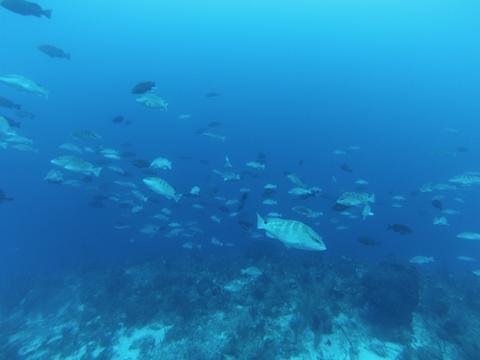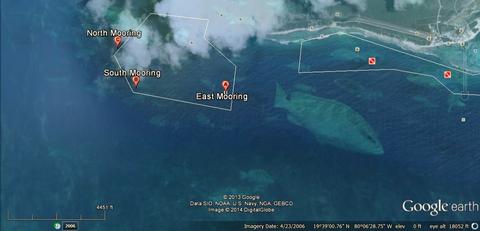
After landing in style in my private charter, I was met by the Cayman Department of the Environment (DOE) welcoming crew with a green, grumpy grouper t-shirt. The DOE assists with the Reef Environmental Education Foundation (REEF) for their own data collection of the Grouper Moon project. Among the committee were Laura, DOE staff, and Alex from the Guy Harvey Ocean Foundation here in Little Cayman. We hit the road to where I was staying and within hours I was on my first dusk dive about to meet the other welcoming party – the aggregating Nassau grouper.
Aside from Christy and Brice, Steve Gittings, Science Coordinator for NOAA’s National Marine Sanctuary Program, has come to participate in his six year working on the project, along with some other REEF volunteers: Leslie, Brenda, Lynn and Hal.
So far, we have been keeping counts on the abundance of Nassau grouper making notes on the percentage of color changes along with displays of behavior as the numbers of fish increases at the spawning site until the main event begins. The site itself is protected by the Cayman government as a Marine Protected Area (MPA), and is a large promontory with a shallow plateau at 70 to 80 feet and drops off at a wall to 1000s of feet below. There are three moorings at north, south and east positions along the plateau that assist with providing a reference for where the grouper are congregating and finding your way back to the boat. I arrived on the evening of the full moon, so it will still take a few days for all the Nassau grouper to leave their resident areas and migrate to the site.
So far, there have been only a few 100 grouper to count but at the time of the mass spawning the abundance threshold should increase into the 1000s. This is an exciting time with great anticipation among the divers and the fish themselves. Other species are aware of the happenings here on the reef as well. Schools of horse eye jacks and ocean triggerfish, as well as a lone dog snapper have been hanging around the grouper, and it will be interesting to see how all the reef community comes into play when the spawning occurs.

